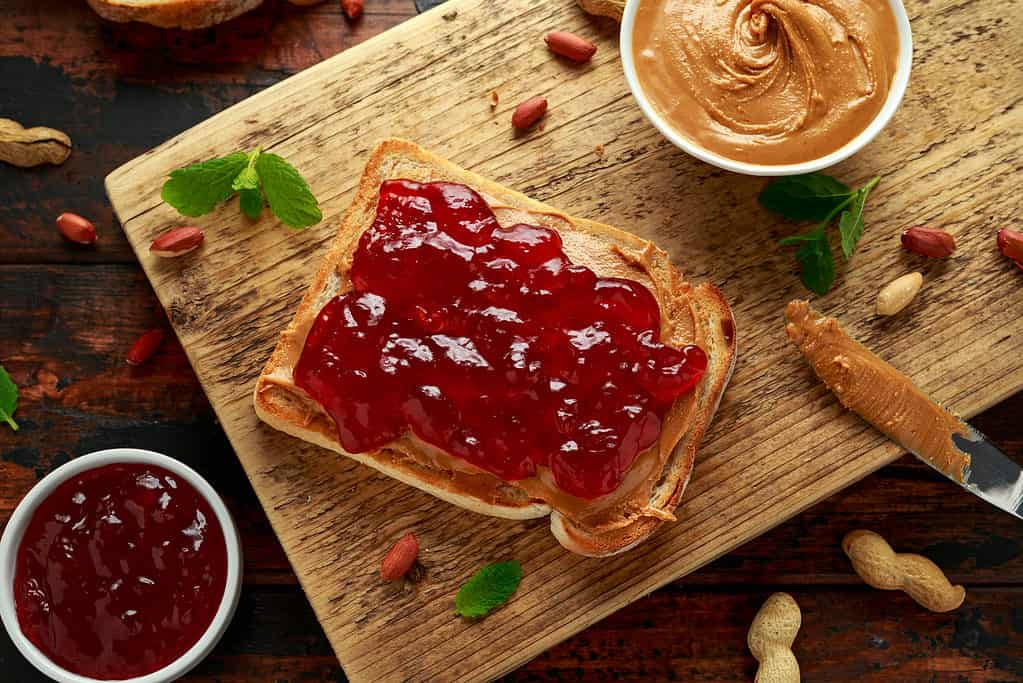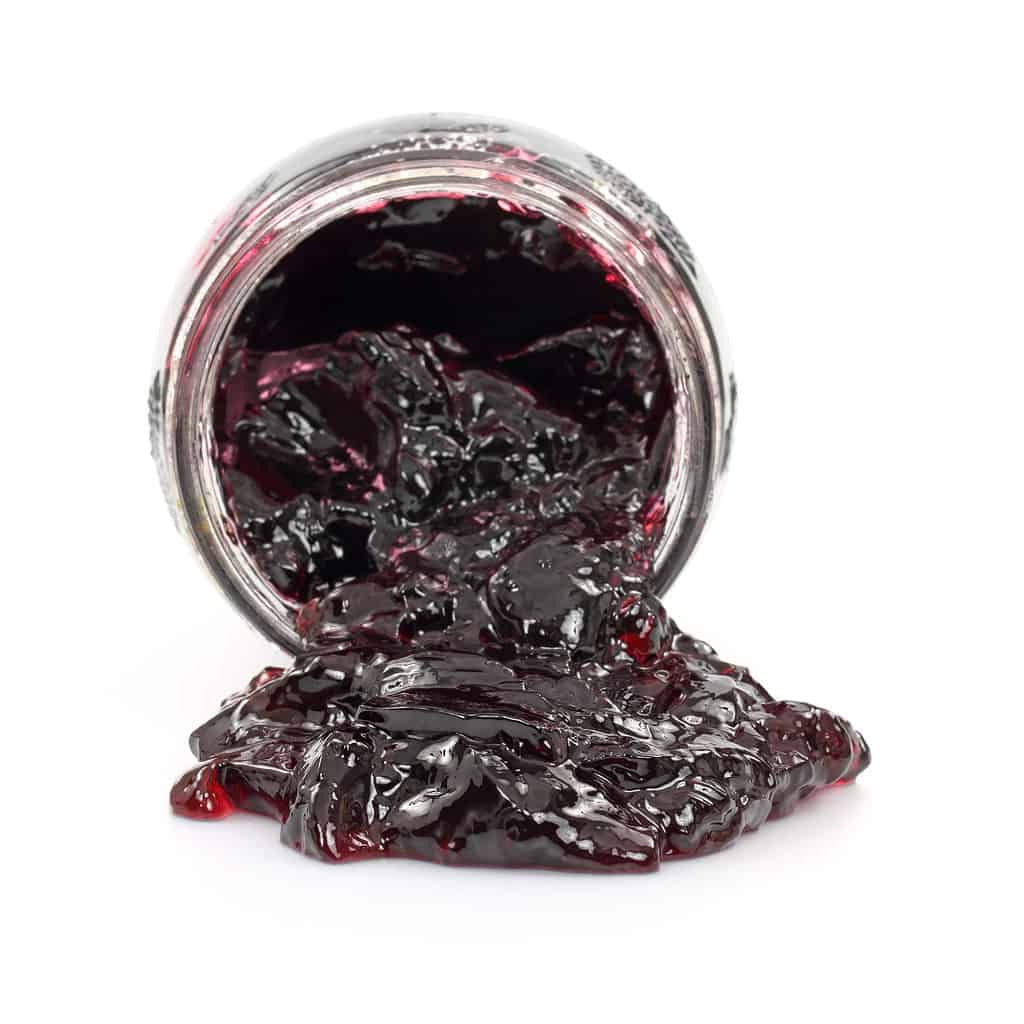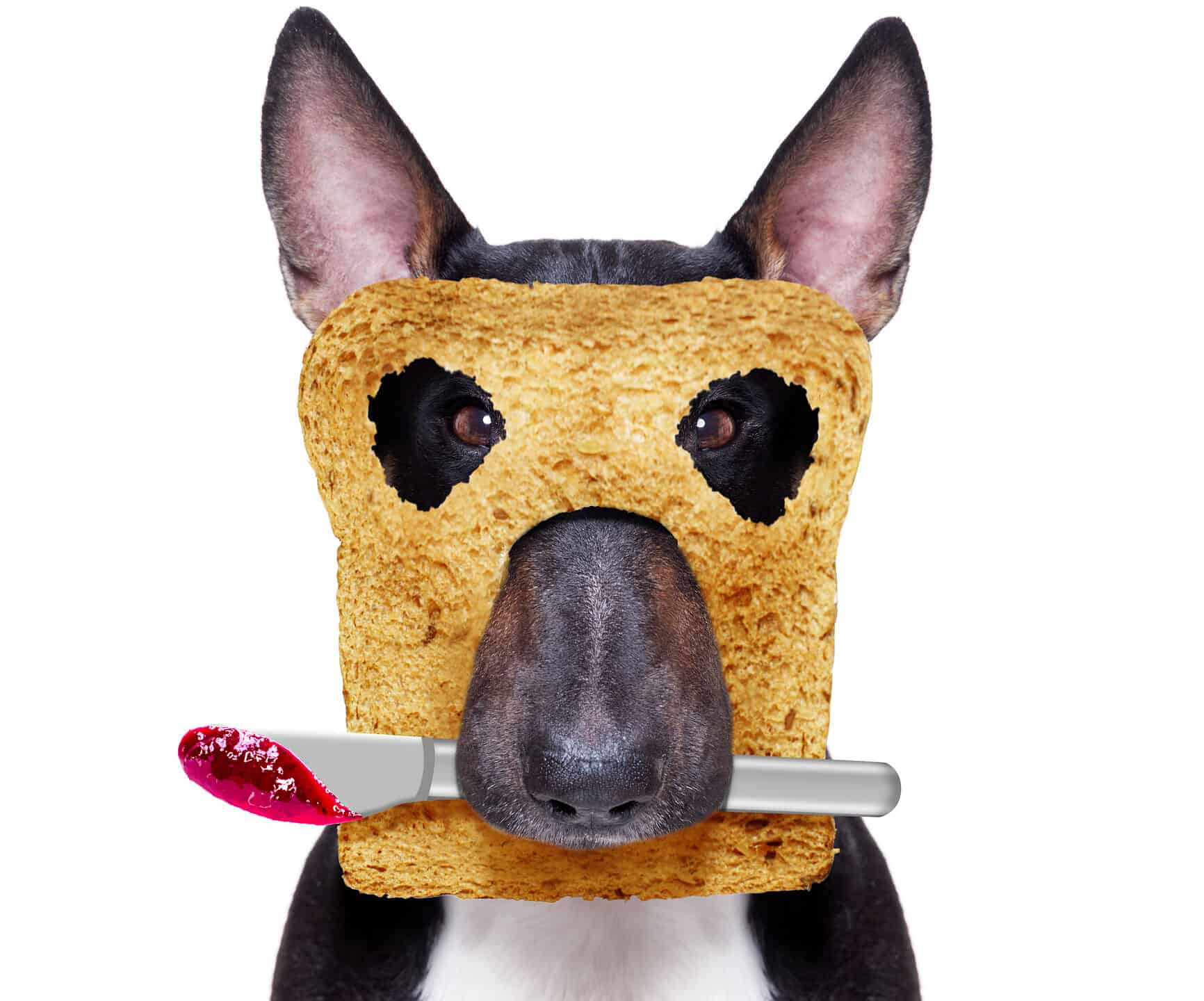Jelly is a fruity spread enjoyed by lots of people in a wide variety of styles including on toast, in cakes, in smoothies, and even as an ingredient in meat sauces. Its sweet smell is enough to make dogs drool and attempt to levitate the morsel with their eyes, but can dogs eat jelly, or is it toxic?
Let’s uncover whether jelly is a sweet treat dogs can enjoy too.
Is Jelly Safe For Dogs?
The short answer is no, jelly isn’t safe for dogs to eat.
If they gobble down a piece of dropped jelly on toast, chances are it won’t hurt them, but giving jelly on a regular basis is unhealthy and could even poison your dog depending on the ingredients.
We’ll look at the exact reasons a little later on but first, what is jelly?

While small amounts of natural peanut butter is ok for dogs, jelly is not safe for dogs to eat.
©iStock.com/DronG
What Is Jelly?
It depends on where you live!
In America, jelly is filtered fruit juice cooked in pectin (jam is technically made with complete fruits, but it’s often called jelly too). In Europe, jelly is the flavored gelatin that Americans call Jell-o.
Jelly, jam, and Jell-O are not suitable for dogs, so it doesn’t matter if you mix the names up. For the purposes of this article, jelly refers to the American variety of fruit cooked up in pectin and sugar.
Jelly is made by extracting fruit juice from fruits and cooking it up with sugar and pectin. Once the ingredients have melted and mixed together it’s left to set. Jelly doesn’t get hard, but remains semi-liquid so it’s easily spreadable.
All kinds of fruit can be made into jelly from strawberries to blueberries, plums, and greengages if it’s fruit it’s fair game! Jelly is especially suited to sharp fruit like crab apples and quince that don’t taste sweet straight from the branch.
Are you wondering what pectin is? Good question!
Pectin is a soluble fiber found in the cell walls of fruit and veg. It’s used to thicken liquids and it’s a bit like glue. Its name is taken from the ancient Greek for pektos which means to harden or firm.
Does Jelly Have Any Health Benefits?
Jelly is made from fruit, so you might expect it to be packed with healthy vitamins and minerals, but this isn’t the case. The high temperature jelly is boiled at destroys the majority of its fruity goodness, so it isn’t healthy for dogs or humans.
What Are the Risks?
Jelly is not good for dogs and although a small amount shouldn’t present any harm, there are some risks if they eat a lot of jelly in one go or eat smaller amounts on a regular basis.
Let’s start with the two potential toxic ingredients.
Fruit and Artificial Sweeteners
Jelly is traditionally made using a large amount of sugar, but in low-sugar versions this is replaced by an artificial sweetener. Xylitol is toxic for dogs because they can’t process it the same way we can. Instead of absorbing the sweetener, it creates a big demand for insulin and a huge drop in blood sugar which has led to fatalities. Dogs have died after eating low-sugar chewing gum and skinny ice cream.
Xylitol will be on the ingredients list of store-bought jelly and it’s also present in mouthwash, Jell-o, cough sweets, cakes, biscuits, and toothpaste.
A second potential toxic source is fruit. Dogs can eat apples and bananas, but grapes, raisins, and sultanas are highly toxic. Other fruits such as lemon and lime contain acids that cause gastric upsets too.
There may also be an issue with stone fruit such as peaches, plums, and cherries. Some of the pit (the stone) may be left in as part of the manufacturing process, but pits are dangerous for Lassie because they contain a toxin called amygdalin.

Many jellies contain grapes which are very toxic to dogs and must be avoided.
©iStock.com/BWFolsom
Pectin
There’s lots of debate over pectin for dogs. Some experts say it causes upset stomachs and vomiting, but some vets prescribe it with other medications to soothe stomach problems. The jury is out on pectin for dogs.
It’s High In Sugar
Naturally occurring sugar in fruit is nothing compared to the huge amount of cane sugar added to sweeten jelly. It can be more than 50% of the whole pot! Dogs shouldn’t eat too much sugar for two reasons.
First up, dental problems. Dental problems are expensive and many insurance companies don’t cover poor dental hygiene. Feeding your dog lots of sugar has the same effect it has on humans. It causes cavities and decay that leaves the nerves exposed. It’s very painful for a dog to have toothache because they use their mouth for so much.
Another issue with the sugar content of jelly is excess calories. 56% of dogs in the United States are overweight or obese according to the Association for Pet Obesity Prevention. This is a preventable problem that creates a whole host of issues such as diabetes, an increased risk of cancer, and painful joints.
Is Homemade Jelly Good For Dogs?
Usually, homemade dog snacks are a good option because you can control what ingredients are added, but jelly can’t be made with dog-friendly ingredients, it just needs too much sugar!
You could compromise with a homemade Jell-O. Store-bought Jell-O isn’t safe due to the risk of xylitol, but you can make your own type of Jell-O with plain gelatin and use it as a meaty, dog-safe jelly. The ASPCA recommend treat foods make up a maximum amount of 10% of a dog’s daily intake though, and the rest from complete dog food, so don’t go overboard with the delicious gelatin jelly!
What To Do If A Dog Eats Jelly
The first step is to check the ingredients. If it’s a safe fruit and made with sugar, chances are your dog will be fine. They may develop a thirst or a stomach upset such as excess flatulence or vomiting. If this occurs, give them plain simple meals of turkey or chicken and rice until their stools firm up. Any gastric episode that lasts more than a few days requires a vet’s attention because it can lead to dehydration.
If the jelly contained any nasties such as grapes, raisins or xylitol it’s best to consult a vet straight away. They will want to know how much your dog ate and their breed/weight to calculate safe amounts.
Grape and xylitol poisoning can happen within an hour or over several days so keep your eyes peeled. The symptoms are weakness, lethargy, panting, diarrhea, vomiting, and tremors.

Jelly is not good for dogs since it has too much sugar and may contain xylitol, grapes or other harmful ingredients which can cause serious illness.
©Prystai/Shutterstock.com
Can Dogs Eat Peanut Butter And Jelly?
Peanut butter is safe for dogs if it’s xylitol free and we already know the risks around jelly. If both are dog-safe then a little bit on occasion won’t hurt, but large or regular amounts will increase your dog’s weight and put them at risk of life-limiting diseases.
And What About Jam?
Jam is pretty much the same thing as jelly in the States, the difference is jam is made using whole fruits rather than sieved fruit juice, but it’s still off the menu for dogs because it can contain xylitol, toxic fruits, and has a way too high sugar level content for pups.

The difference between jam and jelly is that jam is made using whole fruits rather than sieved fruit juice, but it’s still not good for dogs.
©iStock.com/yacobchuk
What Foods Are Poisonous For Dogs?
As well as grapes, raisins and xylitol there are other dog-toxic food and drinks to avoid. Chocolate, macadamia nuts, black walnuts, bleu cheese, nutmeg, onions, garlic, leeks, shallots, and alcohol are all dangerous.
Food containing these ingredients are also toxic. Garlic bread for example, salad with onion, and cake with macadamia nuts are all capable of causing sickness or even killing your dog.
Is Jelly OK For Dogs?
So, to recap can dogs eat jelly, the overall answer is no.
Dogs shouldn’t eat jelly because the risk of xylitol poisoning is high and it’s so sugary it causes weight gain and cavities. A small amount probably won’t cause a problem, but it’s best to avoid feeding your dog any jelly or jam products.
There are many healthier snacks a dog will enjoy instead, so jelly isn’t essential no matter how desperate their drooling becomes. Apple slices, blueberries, or even occasional puppucinos are better choices than jelly.
Up Next
- Can Dogs Eat Jell-O? Is It Safe or Dangerous?
- Can Dogs Be Vegan? What Are The Risks?
- Can Dogs Eat Applesauce? The Risks And Benefits
Ready to discover the top 10 cutest dog breeds in the entire world?
How about the fastest dogs, the largest dogs and those that are -- quite frankly -- just the kindest dogs on the planet? Each day, AZ Animals sends out lists just like this to our thousands of email subscribers. And the best part? It's FREE. Join today by entering your email below.
Thank you for reading! Have some feedback for us? Contact the AZ Animals editorial team.








